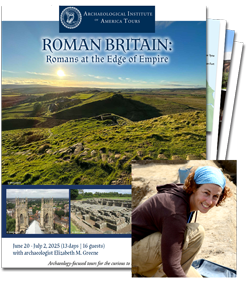
Sponsored by: AIA Tours

Follow in the footsteps of the ancient Romans in Britain as you venture north from Chester, England, to Edinburgh, Scotland, with a foray along Hadrian’s Wall, which was famously constructed ca. A.D. 122 along the northwest frontier of the Roman Empire. Experience a world at the edge of the Empire and amidst the natural beauty of old medieval towns, verdant countryside, and the scenic Lake District, discovering for yourself the remains of formerly vibrant Roman forts and towns, museum collections of fascinating Roman artifacts, and Rome’s influence on the Britain of today.
Highlights:
•Visit two sites that comprise the UNESCO World Heritage Site “Frontiers of the Roman Empire”: Vindolanda, not only one of Europe’s most important Roman sites but also where your AIA lecturer/host has been doing fieldwork since 2002; and Arbeia Roman Fort, which was a key supply base to Hadrian’s Wall.
•Take a walking tour of the 1st-century A.D. Roman fortress-town of Chester, home to the most complete ancient city walls in Britain as well as Britain’s largest Roman amphitheater.
•Explore the bustling lanes of York, which was established as a Roman garrison town in A.D. 71 and went on to be a Viking stronghold and prosperous medieval city.
•Drive though the breathtaking English Lake District, a UNESCO World Heritage Site, including a cruise excursion on Lake Windermere, England’s largest lake; and a stop at Castlerigg Stone Circle, which is one of the earliest Neolithic stone circles in Britain.
•Walk the streets of the Old and New Towns of Edinburgh, including the historic Royal Mile and Calton Hill, which was considered Edinburgh’s version of Athens’ Acropolis in the 19th century, and are altogether a UNESCO World Heritage Site.
•Marvel at museum collections showcasing spectacular Roman finds and more, including the Yorkshire Museum and Gardens; Great North Museum: Hancock, whose collections include carved and inscribed stones from Hadrian’s Wall, among many other treasures; Vindolanda’s nearby Roman Army Museum; and Edinburgh’s National Museum of Scotland.
Notifications